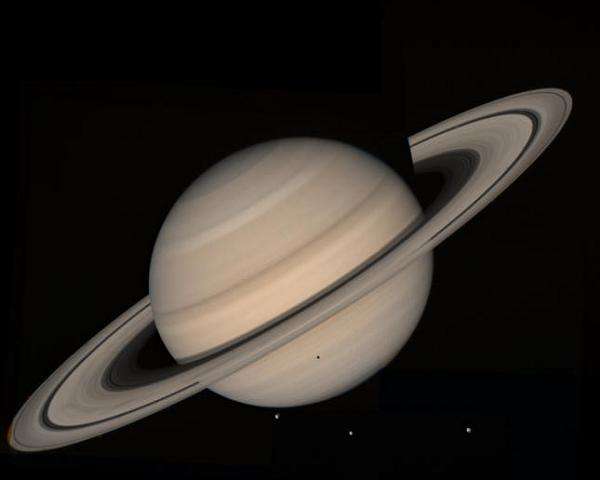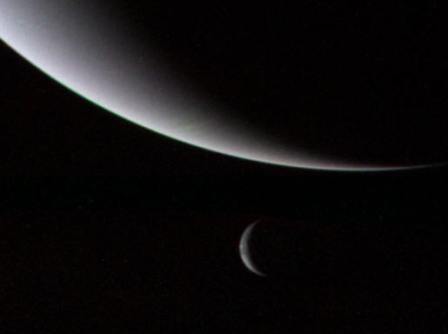|
VOYAGER 2
By Thamayanthi Giritharan
 In the midst of the Cold War, space enthusiasts were shrewd to take advantage of
the competitive panic during the Space Race. With space exploration as a new
curiosity to several, many astronomers were eager to collect more data. During
the 1970s, the major outer planets of Jupiter, Saturn, Uranus and Neptune were
still relatively unknown objects. As a result, NASA (National Aeronautics and
Space Administration) sent two, unmanned spacecrafts to study these planets,
Voyager 2 and Voyager 1, as part of the Voyager program. Voyager 2, however, is
probably one of the most productive spacecrafts to date. The purpose of this
paper is to inform the reader of the general outline of, key data and
conclusions gathered from the gas giants of the Solar System, and other current
and future events from Voyager 2. In the midst of the Cold War, space enthusiasts were shrewd to take advantage of
the competitive panic during the Space Race. With space exploration as a new
curiosity to several, many astronomers were eager to collect more data. During
the 1970s, the major outer planets of Jupiter, Saturn, Uranus and Neptune were
still relatively unknown objects. As a result, NASA (National Aeronautics and
Space Administration) sent two, unmanned spacecrafts to study these planets,
Voyager 2 and Voyager 1, as part of the Voyager program. Voyager 2, however, is
probably one of the most productive spacecrafts to date. The purpose of this
paper is to inform the reader of the general outline of, key data and
conclusions gathered from the gas giants of the Solar System, and other current
and future events from Voyager 2.
Voyager 2 was launched before its sister probe, Voyager 1, on August
20, 1977. It was launched by Titan IIIE (space booster rocket) in Cape
Canaveral, Florida. Like its twin, it is comprised of 65,000 individual parts,
including powerful cameras. It was at a fraction of the cost when compared to
future probes, such as Cassini-Huygens. Unlike its twin, it followed a slower
flight path in order to be kept in the solar system’s plane, otherwise known as
the ecliptic. This allowed Voyager 2 to travel to Uranus and Neptune with a
gravity assist from Saturn. The completion of the Planetary Grand Tour was made
possible through Voyager 2. NASA sought to send probes to the outer planets via
gravitational assist during the alignment of all the outer planets (a phenomenon
that would take place in the late 1970s and not again for another 176 years).
Hitherto, it is the only spacecraft to travel to Uranus and Neptune (also being
the first). Voyager 2 has had flybys of Jupiter, Saturn, Uranus and Neptune.
Its flyby of Jupiter occurred on July 9, 1979. It reached within
570,000 kilometres of Jupiter’s cloud tops. Voyager 1 already visited the
planet earlier, having taken 19,000 images and Voyager 2 took another 14,000.
With the two probes, important comparisons could be made to reveal different
characteristics of not only Jupiter, but its major moons and ring system as
well. Through Voyager 2’s journey between Jupiter and Saturn, it found that
Jupiter’s magnetotail extended to at least Saturn’s orbit around 650 million
kilometres away. The magnetotail is the part of the magnetosphere (the area
around a planet where its magnetic field is present) facing away from the Sun
because of its interaction with solar winds.
Through Voyager 2’s images, a small satellite, Adrastea, was
discovered orbiting just outside the main ring of Jupiter. Due to its similar
composition to the rings of Jupiter, it is thought to be the main contributor to
the ring system (as debris from the moon when meteorites bombard its surface).
However, it was another moon that probably brought more revelation. Volcanic
activity was detected on Io, making it the first time active volcanoes to be
seen on any other object in the solar system. Sulphur, oxygen and sodium are
believed to spew from the volcanoes. When Voyager 2 made its flyby, eight of
the nine volcanoes were active, with the ninth one shutting down during the
interval between Voyager 1’s departure and Voyager 2’s arrival. Ionian activity
is thought to be a possible factor of “changes” seen in Jupiter and its
surrounding region. For example, the sulphuric concentrations detected in the
magnetosphere by both Voyagers were not detected by the Pioneers five years
earlier.
Voyager 2’s flyby of Saturn took place on August 26, 1981. It
searched Saturn’s upper atmosphere. Winds were found to be about 500 meters per
second, most to be blowing easterly and strongest at the equator. Moreover,
symmetry between north and south winds were measured through Voyager 2. This
symmetry led some to conclude that the winds may stretch from north to south
through the core of Saturn.
Voyager 2 showed that Saturn seemingly plunged into Jupiter’s
magnetotail. There were areas where Saturn’s radio emissions could not be
detected. Areas where the Jovian magnetotail appeared to exist were believed to
be where the radio emissions were undetectable. This suggests that the Jovian
magnetotail exists to this point, but there is no explicit evidence.
Along with Voyager 1, Voyager 2 aided in the mapping of Saturn and
its satellites, including its superlative rings. For example, the satellite,
Phoebe, was probed by Voyager 2 and found to orbit Saturn in retrograde motion
(opposite to the other satellites). Six new satellites were found, including
three found by Voyager 2. Titan was found to be the most captivating satellite
with chemistry in the atmosphere to be that of an Earth’s atmosphere several
billion years ago.
Voyager 2 was closest to Uranus on January 24, 1986 within 81,500
kilometres of its cloud tops. It made many important observations, such as
discovering 10 moons, studied its ring system (including a discovery of two new
rings) and its unique axial tilt of about 97.8°. Uranus’ magnetotail is
believed to continue to at least 10 million kilometres behind it. Due to its
axial tilt, some wondered whether a magnetic field existed. Voyager 2 abolished
those doubts by showing Uranus had an intense, yet skewed magnetic field that
was tilted to a 60° angle to its rotational axis. Its intensity is similar to
Earth’s, but it varies from points because of its offset from the centre.
However, the source of the magnetic field is unknown. Theories of water and
ammonia pressurized within the core seem to have been eradicated with Voyager’s
findings, making the source of the magnetic field still a mystery.
Voyager 2 found that Uranus’ radiation belt’s intensity was
comparable to Saturn’s, but it was of a different constitution. The belt is
believed to be mainly made of hydrogen ions. The intensity is great, and
because of this, irradiation would darken any methane in the surfaces of the
inner moons or ring particles within 100,000 years. This is thought to be the
explanation of the darkened surfaces of Uranus’ satellites.
One of the innermost moons of Uranus, Miranda, had some grand
peculiarities. Images from Voyager 2 shows fault canyons as deep as 20
kilometres and an amalgamation of young and old surfaces. From this, some have
inferred that Miranda may be a remoulding of material from a previous time when
it was shattered by a violent collision.

The closest approach to Neptune by Voyager 2 occurred on August 25,
1989. Neptune was the last gas giant and last planetary target on Voyager 2’s
mission. As a result, Neptune’s largest moon, Triton, was taken into further
study. It was found that geyser-like activity occurred on Triton. Eruptions
would emit nitrogen and dark particles 2 to 8 kilometres upward before falling
down. In addition to two already known moons (one being Triton), six new moons
and a ring system were found through Voyager 2. It made its closest approach to
any planet since its launch, passing 4,950 kilometres above Neptune’s North
Pole.
The probe photographed the Great Dark Spot on Neptune, similar to
that of Jupiter, but relatively cloud-free. Around the region, the retrograde
winds were measured to be 2,400 kilometres per hour – among the fastest in our
Solar System. The Great Dark Spot is thought to be a hole in the methane deck,
similar to holes in Earth’s ozone layer. Large white clouds have also been
found swirling about Neptune. They were akin to Earth’s cirrus clouds, but
instead of being made of crystals of ice, they were made of crystals of frozen
methane. The Great Dark Spot has since disappeared (as seen through images from
the Hubble Space Telescope).
Voyager 2’s expedition of Neptune also led to the now demoted status
of Pluto. Predicted and observed positions of Uranus and Neptune differed,
leading many to believe that the gravity of a “Planet X” influenced these
discrepancies. However, with Voyager 2’s findings, it was found that Neptune’s
mass was 0.5% less than that of what was predicted earlier. (This difference is
about the mass of Mars) Therefore, it was the mistaken mass number and not the
gravity of “Planet X” (Pluto) to be causing these incongruities. Nevertheless,
it took another 17 years to officially downgrade Pluto from planet to “dwarf
planet.”
Thirty-one years later, Voyager 2 continues to explore beyond what
the eye cannot see. It has definitely been one of the most productive probes
to date, visiting all four gas giants and their satellites. After the Neptune
mission, it has entered its Interstellar Mission Phase, having escaped the solar
system’s trajectory. It is journeying into a space beyond the heliosphere (the
bubble in space that is pushed into the interstellar medium by the solar wind;
almost all material here is from the Sun). The most recent conjecture
(published in July 2008) from the data was that the heliosphere is not perfectly
round, but squashed. Voyager 2 crossed the boundary between the heliosphere and
the rest of interstellar space closer to the Sun than expected. This led to the
theory that the heliosphere in this region is pushed closer to the Sun (inward)
by an interstellar magnetic field. This helps us learn how the Sun relates with
the encompassing interstellar medium.
The future is, as it always is, uncertain. As of May 2008, Voyager
2 is about 85.84 AU from the Sun and continues to travel at about 3.28 AUs per
year. By 2016, it is expected to terminate its gyro operations. Voyager 2 is
expected to cease transmission 48 years after its launch, in 2025. In around
296 millennia, it is anticipated to pass by Sirius, the brightest star in the
northern sky. The probe has already surpassed many of the wildest dreams. We
will just have to wait for what happens next.
SOURCES
I. http://www.nasa.gov/mission_pages/voyager/voyager-20080703.html
II. http://nssdc.gsfc.nasa.gov/planetary/voyager.html
III. http://video.google.com/videoplay?docid=1825648771198195435
IV. http://voyager.jpl.nasa.gov/science/thirty.html
V. http://voyager.jpl.nasa.gov/
VI. http://voyager.jpl.nasa.gov/spacecraft/spacecraftlife.html
VII. http://pds.jpl.nasa.gov/planets/welcome/voyager.htm |

